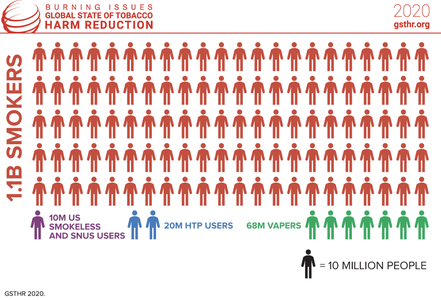Smokers in Billions
Knowledge•Action•Change (2020)- Burning Issues: The Global State of Tobacco Harm Reduction 2020
Globally there are 68 million people vaping, 20 million using heated tobacco products and 10 million using snus or US smokeless. This might look like a success, particularly for vaping and heated tobacco products which are recent introductions, but is it? A bleak assessment would be not yet. 98 million users of safer nicotine products (SNP) is minuscule compared with continued use of combustible products by 1.1 billion smokers. It only amounts to nine SNP users for every 100 smokers and six vapers for every 100 smokers.
Despite the enthusiasm for safer alternatives, the rate of progress in switching from smoking to SNP is slow. There is an urgent need to scale up tobacco harm reduction. What is needed to make this happen is for products to be:
» Available - Regulation and control should be geared to making these products as readily available as other consumer goods, given that independent and internationally agreed products safety standards are in place. So no outright bans, no flavour bans, no regulation as medicinal products and no exorbitant tobacco-style taxation. Instead, are there ways to incentivise both industry and consumers to switch instead of trying to stub out safer nicotine alternatives?
» Affordable - This links to the question of consumers’ ability, especially in lower and middle-income countries, to afford products. A supportive legislative landscape is required, and other obstacles need to be overcome. For example, mobile phones are ubiquitous across Africa with the capacity to charge them up, so affordable, rechargeable vaping devices must be a possibility, if the will is there from the manufacturers.
» Appropriate - Vaping devices might work to replace cigarettes in many countries but won’t be appropriate everywhere and with all communities. There are many nicotine consumers, especially in India and South East Asia, who don’t smoke conventional cigarettes but instead smoke local varieties or use a range of even more dangerous smokeless tobacco products. It would be hugely beneficial from a public health perspective if these dangerous smokeless products were replaced by far safer snus- type smokeless products.
» Acceptable - Public health and commercial marketing strategies would need to account for long-standing social and cultural custom and practice, the nature of the messaging, who is delivering the messages and by what means.
See also p.55 of the report: Burning Issues: The Global State of Tobacco Harm Reduction 2020

